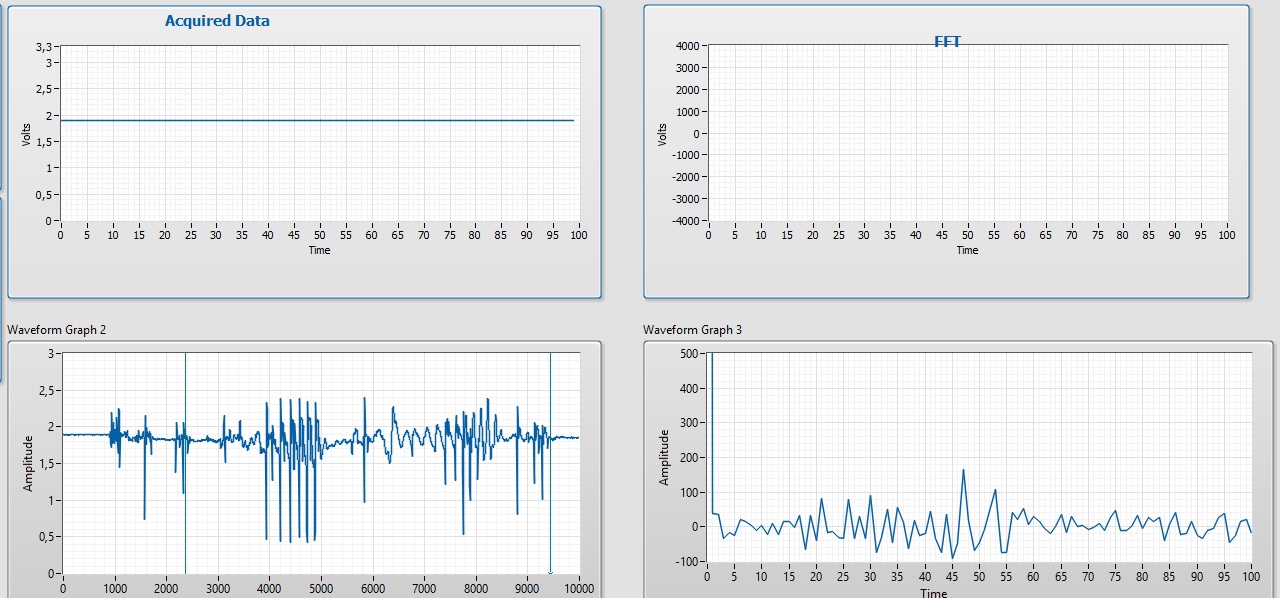- Subscribe to RSS Feed
- Mark Topic as New
- Mark Topic as Read
- Float this Topic for Current User
- Bookmark
- Subscribe
- Mute
- Printer Friendly Page
Freeze and Frequency Analysis
Solved!12-08-2016 05:12 AM
- Mark as New
- Bookmark
- Subscribe
- Mute
- Subscribe to RSS Feed
- Permalink
- Report to a Moderator
Hey Alex,
I still have just a straight line. Its like my MEMS gets no data, but i made a test in the DAQmx and the hardware works fine. I added some screenshots. You have any idea? 😞
The error message is also strange because i setted everywhere the same rate(1kHz) and samples(100) like ago. Or did i missed it somewhere?
Thank you very much!
12-08-2016 05:15 AM
- Mark as New
- Bookmark
- Subscribe
- Mute
- Subscribe to RSS Feed
- Permalink
- Report to a Moderator
12-08-2016 09:02 AM
- Mark as New
- Bookmark
- Subscribe
- Mute
- Subscribe to RSS Feed
- Permalink
- Report to a Moderator
no change 😞 just a straight line at -5 volts
12-08-2016 10:09 AM
- Mark as New
- Bookmark
- Subscribe
- Mute
- Subscribe to RSS Feed
- Permalink
- Report to a Moderator
Alex... i think i know why.. is it because i have changed the DAQ card? last week i used the SCB 68a with a PCI card. Now its a USB 6001 from NI
12-09-2016 04:02 AM
- Mark as New
- Bookmark
- Subscribe
- Mute
- Subscribe to RSS Feed
- Permalink
- Report to a Moderator
Thank you very much for your help and your patience! It works 
For understanding: 1. why makes the FFT in the first milliseconds always this one big peak?
2. the amplitude in the FFT is in Herz?
For the program:
3. could it also be possible to vary the waveform graph 2 and 3 from 10 seconds manualy into 15 or 20 seconds? e.g. through a rotary knob?
12-09-2016 05:29 AM
- Mark as New
- Bookmark
- Subscribe
- Mute
- Subscribe to RSS Feed
- Permalink
- Report to a Moderator
Hello Gregory88,
1. This could be the dc part in your signal.
2. What are the Output Units of FFT-based VIs?
3. Attached
Alexander
12-09-2016 06:32 AM
- Mark as New
- Bookmark
- Subscribe
- Mute
- Subscribe to RSS Feed
- Permalink
- Report to a Moderator
Hi Alex,
thank you it´s also a nice feature, it´s great thou, but i would like to scale the x-axis and maybe y-axis by a rotary knob.
Furthermore i tried to write the data from the "waveform 2" & "waveform fft2" into a excel chart to print and compare them. Attached my VI with Express tools ![]() does´nt work as expected 😕
does´nt work as expected 😕
12-12-2016 01:22 AM - edited 12-12-2016 01:25 AM
- Mark as New
- Bookmark
- Subscribe
- Mute
- Subscribe to RSS Feed
- Permalink
- Report to a Moderator
Hello Gregory88,
How Do I Programmatically Format the X-Axis of a LabVIEW Graph to Display Timestamps?
With this way you can set also the minimum and the maximum for each axis.
There is also a method export grap to excel
Daten von NI LabVIEW nach Microsoft Excel übertragen
Save to a series of files and use the true to generate a new one.
Alexander
12-14-2016 05:26 AM
- Mark as New
- Bookmark
- Subscribe
- Mute
- Subscribe to RSS Feed
- Permalink
- Report to a Moderator
Hi Alex,
the scale with the x and y axis doesnt work, just the description changes the graph stays constant. 😕
An "extra" idea for my VI is to create sth like a RMS - all three voltage signals (x-y-z-axis from the analog sensor) could combine together and could be visual in an extra waveform. would be usefull that i dont have to switch between the 3 signals of the sensor and compare everyone after each measurement.
attached the VI
12-14-2016 06:26 AM
- Mark as New
- Bookmark
- Subscribe
- Mute
- Subscribe to RSS Feed
- Permalink
- Report to a Moderator
Hello Gregory88,
like this
for the scaling the range maximum property can be used.
Alexander


